Build confidence before competence: AI adoption succeeds when people see results early. Start with small, no-code automations that save time on repetitive HR tasks. Early wins build trust and confidence, helping teams shift from hesitation to ownership.
Shift leadership from control to clarity: In an AI-driven environment, leaders no longer need to approve every task, they need to design better decisions. Focus on setting intent, defining workflows, and enabling teams (and AI systems) to self-organize around clear goals.
Create internal AI champions: Sustainable AI adoption comes from within. Identify curious, influential team members to become AI champions — peers who teach, troubleshoot, and improve workflows. This distributed model scales learning, governance, and innovation across the organization.
So, she began consulting businesses focused on proper AI integration, and then created a framework around her practices.
We caught up with her to get the details of her playbook. Here's what she told us.
From corporate HR to AI consultancy
I’m Rey, a Canadian HR consultant and trainer with over 16 years of international experience in HR and talent management. I hold an MBA from Royal Roads University. I’m also an ICF ACC-certified coach and OKR coach.
I got into AI because, after years in HR and talent management, I saw the same pattern repeating — HR teams drowning in admin work while struggling to prove strategic impact. When AI tools started emerging, I realized most HR leaders were either ignoring them or feeling overwhelmed by the tech side. I wanted to bridge that gap.
My focus became helping HR leaders use AI in a non-technical, results-oriented way — to automate the repetitive, focus on people, and make data-driven decisions without relying on IT or consultants. It’s about making AI practical, ethical, and directly tied to business outcomes.
Overall, my leadership journey has been shaped by a mix of cross-cultural experience and continuous reinvention. A few milestones stand out:
- Transitioning from corporate HR to consultancy: After more than a decade leading talent and organizational development in the Middle East, I realized many HR functions needed simpler, more agile systems — not just bigger frameworks. That led me to advisory work.
- Becoming an ICF ACC Coach and OKR Coach: This shifted how I lead and develop others. Coaching taught me to drive accountability through clarity rather than control.
- Integrating AI into HR practice: I built AI HR training programs to help leaders modernize workflows without relying on IT. Watching clients transform from hesitant to confident AI adopters was a defining moment.
- Building cross-border credibility: Coming from Canada and working across diverse Middle Eastern markets has shaped how I lead multicultural teams and design people strategies that actually scale.
How AI is redefining leadership from decision maker to decision designer
In an AI-first world, leadership is less about holding knowledge and more about orchestrating how knowledge flows. Three shifts stand out:
- From control to clarity: I’ve had to unlearn the assumption that strong leadership means setting direction and monitoring execution. AI has made information and decision power more distributed. Now, leadership is about setting clarity of intent — what problem we’re solving — and letting teams (and tech) self-organize around that.
- From process ownership to capability building: In traditional HR, we “owned” processes — performance reviews, succession, recruitment. Now my focus is on building AI-enabled capabilities in others so those processes run smarter and faster without constant oversight.
- From linear hierarchy to networked collaboration: I’ve let go of the belief that structure creates accountability. AI tools cut across silos, so influence now travels horizontally, not just vertically. This demands psychological safety, data transparency, and leaders comfortable with shared authority.
Ultimately, leadership today isn’t about being the decision-maker — it’s about being the decision designer.
That means I'm spending less time approving outputs and more time coaching teams on designing workflows, prompts, systems, and guardrails, as well as fostering distributed accountability
It’s a subtle but profound shift in mindset: AI doesn’t just make work faster — it forces leaders to reconsider what leadership actually means in a knowledge-driven, automated environment.
Leadership today isn’t about being the decision-maker — it’s about being the decision designer.
What it really means for your organization to be AI-ready
Being AI-ready in our organization looks like this:
- People who can identify tasks suited for automation.
- Teams that can design, test, and refine AI-driven workflows.
- Leaders who evaluate outputs critically, ensure ethical use, and maintain governance.
Here are the problems I often see:”
- Overhype vs. reality: Teams initially expect AI to replace judgment rather than augment it.
- Resistance to change: Some staff are hesitant to trust AI outputs without hands-on wins.
- Governance gaps: Early iterations risked inconsistent quality or bias, requiring prompt libraries and review checkpoints.
By combining practical application, peer-led coaching, and governance, we’ve built an AI-literate, capable, and responsible HR function, where AI augments decision-making rather than creating dependency.
How to close the gap between AI expectations and real-world execution
The biggest disconnect I see right now is expectation versus execution.
Organizations often treat AI as a “magic fix” that will instantly make HR more efficient or strategic, without addressing the underlying workflows, skill gaps, or culture needed to actually leverage it. The result is AI adoption that either stalls, produces inconsistent results, or amplifies existing inefficiencies.
I address this in two ways in my leadership and org design:
- Workflows before tools: I ensure that every AI initiative starts with a clear understanding of the process it’s meant to improve. We map pain points, define outcomes, and only then select or design AI solutions. This prevents tools from being used as a band-aid and shifts focus to capability-building rather than just automation.
- Distributed leadership via AI champions: Instead of relying on a single expert or leadership figure to implement AI, I create internal champions who can teach, troubleshoot, and iterate within their teams. This both scales adoption and embeds AI fluency into the organizational DNA.
Ultimately, closing the gap isn’t about the technology itself — it’s about aligning people, processes, and governance so that AI can actually deliver on its promise without creating new bottlenecks or risks.
Let's dive deeper into this.
How HR leaders can build AI-enabled capabilities that scale
As I said, building AI-enabled capabilities starts with re-engineering workflows; not training people on tools.
Build confidence before competence
I start by focusing on identifying where human effort adds the least value — repetitive reporting, manual screening, or documentation — and I redesign those processes with simple, no-code automations via platforms like Zapier, Power Automate, and Airtable. This allows people to see immediate time savings, and they become more open to learning. This “confidence before competence” approach helps HR teams shift from resistance to ownership, as they begin to see AI as a practical productivity lever rather than a threat.
For instance, in new-hire employee onboarding, instead of HR manually transferring data and generating documents, an automation is set up: Once a candidate signs their offer, a no-code workflow is triggered to automatically push the new hire's details to the HRIS — eliminating manual screening/data entry — and simultaneously generate and send an equipment request to the IT department, drastically reducing administrative effort and freeing up HR to focus on high-value interactions.
Embed function-specific learning
Once confidence is built, I embed structured, function-specific learning — recruitment, L&D, HR ops, or leadership — always grounded in real use cases. Every capability-building initiative includes ethical and compliance guardrails, ensuring teams use AI responsibly and transparently.
For a recruitment team, this looks like an embedded "AI Screening Workshop" where recruiters learn to use an AI tool to summarize and rank candidates, immediately followed by training on the compliance guardrail — the mandatory use of a "Bias Audit Log" to manually verify and justify any AI-driven decision, ensuring responsible usage.
Similarly, the Leadership team might attend an "AI for Workforce Planning" session to use predictive models, with a core focus on the ethical implications of using AI to inform layoff decisions.
The result is not just tool proficiency but a cultural capability — HR professionals who can redesign workflows, question inefficiencies, and use AI to elevate decision quality. It’s about creating organizations where AI fluency is embedded in everyday work, not treated as a separate skillset.
Develop internal AI champions for sustainable adoption
The training is then sustained by developing internal "AI Champions" — peer mentors who host short office hours to share best practices and troubleshoot new automation workflows, ensuring adoption is continuous and owned by the HR team, not just IT.
I select AI champions by looking beyond their job titles or technical skills — I typically assess three factors:
- Mindset: openness to change, resilience when tools fail, and comfort with ambiguity.
- Influence: their ability to influence others — formally or informally — across teams.
- Execution bias: their ability to turn ideas into working prototypes quickly, rather than waiting for perfect conditions.
The best champions are those who show curiosity about improving workflows and who naturally share what they learn with others. They don’t need to be tech-savvy, but they must be willing to experiment, document what works, and translate it into everyday HR language that their peers understand.
Once selected, I invest in them as internal multipliers — giving them early access to workflows, coaching them on responsible AI use, and positioning them as co-trainers for others. We use structured resources — prompt libraries, SOPs in Notion, and weekly reflection sessions — to make learning repeatable and scalable.
This creates a distributed learning system where capability spreads horizontally through peer credibility — not just top-down initiatives.
Real-world case study: How one HR team cut hiring time by 53% with AI automation
Here's an example of applied transformation I've seen with AI adoption: A 5-person HR team in a regional retail company spent 40% of capacity on admin tasks. Using Typeform, Google Sheets, Zapier, ChatGPT, Slack, and Notion, we automated candidate intake, screening summaries, interview scheduling, and bias-checking. Internal AI champions maintained the workflow and iterated weekly.
This entire candidate-management process is executed via a high-level, no-code workflow:
- Typeform captures application data, which is immediately logged into Google Sheets by Zapier.
- Zapier then forwards the resume data to ChatGPT to generate a three-sentence summary, a fit score, and compliance flags, with the output returned to the Google Sheet.
- If the score is high enough, Zapier sends a Slack notification to the hiring manager with the summary and a link to the candidate's row.
- Upon manager approval within the Sheet, Zapier triggers an automated email to the candidate for self-scheduling the interview.
- Finally, Notion serves as the central hub for the HR Champions to maintain the Bias Audit Log and workflow documentation, ensuring the entire system is efficient, compliant, and continuously improved.
And here are the results:
- 60 hours/week recovered (~1.5 FTE annually)
- Time-to-hire reduced 45 → 21 days (53% faster)
- HR time redeployed to coaching, role design, and improving candidate experience
- Leadership focus shifted from task oversight to capability-building and workflow design
This experience proved to me that AI’s real value is in scaling leadership impact and creating a culture of empowered, capable teams — not just automating tasks.

AI’s real value is in scaling leadership impact and creating a culture of empowered, capable teams — not just automating tasks.
How AI goes beyond operations to transform strategy and decision-making
But AI goes beyond operations. It supports strategy, org design, and decision-making by modeling scenarios, workforce planning, and synthesizing insights, allowing leadership to focus on trade-offs and people impact.
AI for strategic HR and capability-building primarily relies on two types of tools:
- Strategic Planning Platforms: Specialized systems like SAP SuccessFactors or Nakisa/Pigment utilize advanced AI to handle complex workforce planning, scenario modeling, and organizational design. These tools synthesize business data to help leaders forecast needs and analyze the impact of major decisions, enabling HR to focus on strategy rather than just reporting.
- Generative Content Tools: General-purpose LLMs such as ChatGPT or Gemini (often deployed within enterprise platforms like Microsoft 365 Copilot) are used to quickly generate content, including personalized coaching prompts, first drafts of training modules, and employee-pulse survey questions. This automates creative drafting, allowing HR to spend their time coaching and developing people.
In other words, the former establish the data-driven "what" and the latter create the people-focused "how".
Here's what that might look like in practice: SAP SuccessFactors (human capital management software) models a scenario showing a predicted 20% skill gap in Digital Marketing within two years; this strategic insight is then fed into a ChatGPT with a prompt to create a hyper-personalized, three-step coaching plan for a Marketing VP whose team is most affected, effectively translating complex data into immediate, actionable development and coaching content.
The no-code tech stack driving HR workflow efficiency and capability building
Speaking of tools, I use a flexible, no-code stack focused on workflow efficiency and capability-building:
- Google Workspace is my central hub for data, dashboards, and collaboration.
- Typeform and Google Forms standardize candidate and internal intake, feeding automated workflows.
- Zapier (workflow automation software) and Make orchestrate end-to-end automation, freeing 40–60 hours/week. I recently migrated some workflows to Make for better error handling.
- ChatGPT and the OpenAI API generate templates, summaries, and bias checks. These are paired with prompt libraries and logging for consistency and governance.
- Slack (employee communication software) offers real-time notifications and approvals to keep teams aligned.
- Notion (note taking app) is where we document workflows, SOPs, and champion training for scalable knowledge sharing.
The impact of this stack is significant time savings, faster hiring, improved consistency, and a shift in leadership focus from task oversight to workflow and capability design.
How to structure ChatGPT inputs for consistent, bias-checked HR outputs
I’m particularly focused on ChatGPT prompt design and libraries right now. It’s not just using the tool, but how you structure inputs and outputs to consistently generate accurate, bias-checked, and actionable content.
By creating a centralized prompt library, we’ve made AI outputs reproducible across HR workflows — from candidate summaries and screening questions to internal communications and onboarding materials.
The impact has been transformative: it standardizes quality, reduces errors, and frees HR teams from repetitive content creation. More importantly, it changes how I lead — I now spend my energy coaching teams on workflow design, decision guardrails, and iterative improvement, rather than producing or approving every document. This single feature has shifted HR from a task-driven function to a capability-driven, AI-augmented team.
What every HR leader needs to know about navigating the AI transition
Within five years, HR will no longer be defined by transactional processes. Roles like mine will focus almost entirely on designing AI-augmented workflows, shaping decision frameworks, and building human + AI capabilities across the organization. Departments will measure impact by strategic influence, workforce agility, and capability development, rather than headcount or administrative efficiency.
In practice, this means HR leaders will spend less time approving reports and more time curating data-driven insights, coaching teams, and embedding ethical AI use into every decision.
For HR leaders navigating this AI-driven HR transformation, my advice is to focus on workflows, not tools.
Identify where human effort is adding low value, automate or augment those tasks, and invest in building capabilities and AI fluency in your teams. Create internal champions, embed governance early, and shift your role from task execution to designing decision frameworks and enabling others.
More broadly, for all leaders, the key is to rethink how work gets done rather than just what work gets done. Embrace AI as a force multiplier for strategy and culture, prioritize clarity over control, and cultivate teams that can adapt, experiment, and take accountability in an AI-augmented environment.
Success isn’t about having the newest tools; it’s about orchestrating human + AI systems effectively.
Follow along
You can follow Rey on LinkedIn as she explores practical, low-code AI strategies in HR.
More expert interviews to come on People Managing People!



